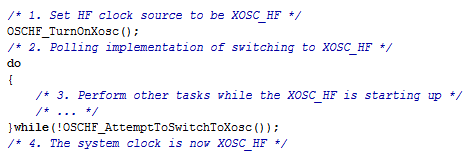SWRA486A August 2015 – April 2017 CC1310 , CC2620 , CC2630 , CC2640 , CC2640R2F-Q1 , CC2650 , CC2650MODA
- CC26x0, CC13x0 SimpleLink™ Wireless MCU Power Management Software Development
-
CC26x0, CC13x0 SimpleLink™ Wireless MCU Power Management Software Development
- 1 Abbreviations
- 2 Power Management Introduction
- 3 TI-RTOS Power Modes
- 4 Implementation Considerations
- 5 References
- Revision History
4.5.1 High-Frequency Oscillators
The CC26x0 and CC13x0 devices boot with the 48-MHz high-speed RC oscillator that clocks the Cortex-M3. When using the radio, switch the main system clock to the high-speed crystal oscillator. The code in Figure 15 shows how to change to the high-speed crystal oscillator (see the functions in driverlib modules osc.h/osc.c).
 Figure 15. Switching from RCOSC_HF to XOSC_HF
Figure 15. Switching from RCOSC_HF to XOSC_HF NOTE
The high-speed crystal oscillator does not start immediately and the application can perform other tasks running on the RCOSC_HF while the XOSC_HF starts.
To optimize power consumption, another function gives the application an estimate of the length of the next XOSC_HF startup. The start-up time depends on the following three factors:
- How long the XOSC_HF has been off
- The operational parameters of the crystal
- The frequency of the RCOSC_HF
The OSCHF_GetStartupTime(uint32_t timeUntilWakeupInMs) returns an estimate of the expected XOSC_HF start-up time, depending on how long the XOSC_HF has been off. For example, the application can use this information to schedule wakeups and ensure that the XOSC_HF starts up before using the radio and transmitting a packet.
NOTE
You must enable the RTC for this functionality to work because the oscillator driver uses the RTC to calculate the start-up time.
You must turn off the XOSC_HF before entering standby or shutdown. To turn off the XOSC_HF, call OSCHF_SwitchToRcOscTurnOffXosc().
NOTE
You cannot switch to the RCOSC_HF before you have switched to the XOSC_HF. Aborting a switch to XOSC_HF is not supported.